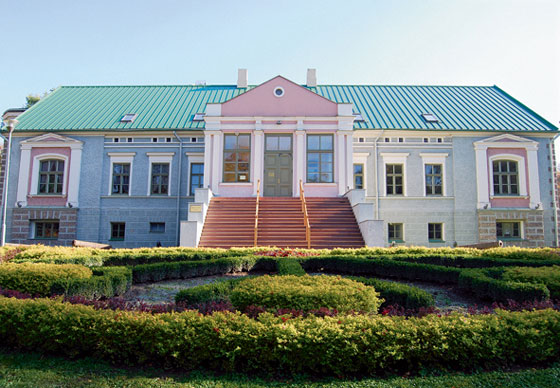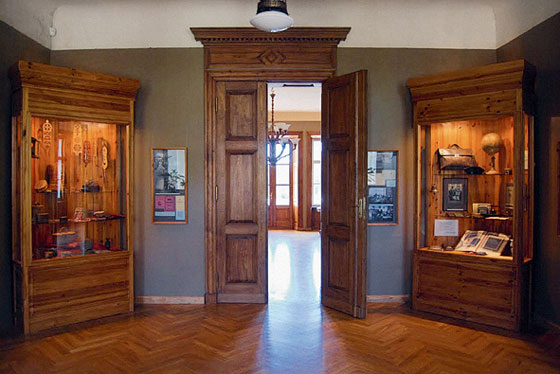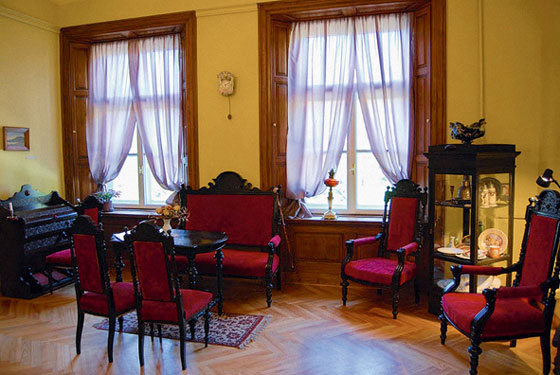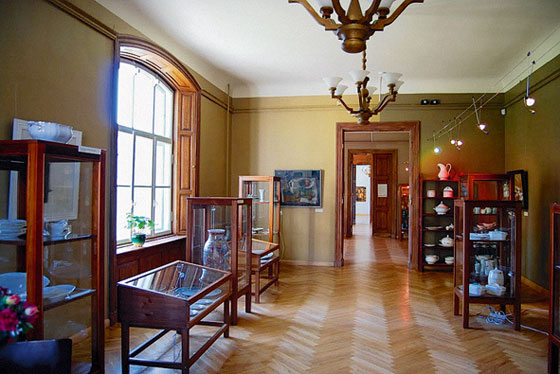|
|
| Talsi District Museum Una Sedleniece, Culture Theorist | |
| To reach the Talsi District Museum (TDM), you must not only ascend one of the nine Talsi hills, but also climb the steep wooden steps leading to the main entrance of the building that was once Georg von Firks’ town villa. What then are the fine details that entice people to visit the museum? First, the museum has very well-groomed surroundings, with sculptures judiciously distributed on the lawns. Second, the yard accommodates a bicycle stand and comfortable benches. Third, the information poster at the museum entrance is charged both visually and in terms of content, and explicitly states that the museum offers seven permanent and four temporary exhibitions, their thematic diversity being suitable for various segments of the public.(1) On the whole, the space around the building inspires trust in the museum as a venue for educational activities and public events consolidating the community. The museum is surrounded by a park featuring a collection of trees, thus bringing together history, art and nature into an organic entirety. | |
 Talsi District Museum. Photo: Una Sedleniece | |
| The museum’s entrance hall is inviting and cosy, and gives the opportunity to learn about the museum’s past straight away by directing attention to a period in the history of Latvia – the 1920s – when many former baronial estates were used to accommodate schools, but in a number of Latvian schools the first collections of local lore were established. Teachers were also the founders of cultural institutions, initiators and leaders of interest groups, archaeologists and researchers. It is significant that in Talsi, professional artists also worked as teachers. The uplifting spirit of culture and education enthusiasts who have selflessly contributed to the creation of the local cultural environment is expressed not only by the introductory exposition but also by the building’s interior with its warm timber facing, unobtrusive ornamental detail and unusual distinctive wooden lighting fixtures on the ceiling, thus creating a subtly homely and pleasant atmosphere. The exhibition titled Recollections from the Age of National Romanticism reveals National Romanticism of the late 19th–early 20th century as one of the as yet modest but potentially very significant research topics and marks of dis¬tinction for the TNM. The first professional Latvian artists from Talsi, Žanis Sūniņš and Kārlis Freimanis, contributed to the search for a distinctive Latvian style of expression in art. Interestingly, the home of the museum’s founder Teodors Dzintarkalns still has the murals painted by Žanis Sūniņš in the 1930s, but the TNM chandeliers have been made after a Kārlis Freimanis design for the lighting fixture of the Talsi Social Association (Talsu sadraudzīgā biedrība).(2) The museum exhibits have been logically grouped and neatly displayed. However, for an individual visitor there is a lack of substance for critical comparison and analysis, whether from a social, historical, or artistic point of view. Stylised folk ornamentation has been used also in the interior of the museum café, thus making the lower ground floor catering premises, rented out to a contractor, match the overall image of the museum. It seems very much to the point that a small exhibition on Kārlis Freimanis is also displayed there. | |
 Museum entrance hall. Introductory exposition about the genesis of the museum. Photo: Una Sedleniece | |
| The use of the national style in everyday objects and items of applied art has been of special significance. Contemplating on this, one must inevitably reflect also about these artists’ contribution to the development of Latvian design and its potential link to what is going on in the world of design today. On the first floor of the museum, an exposition titled Diversity of nature in the Talsi district presents an example of user-friendly contemporary design: a multimedia presentation produced by digital design studio DD Studio featuring Latvia’s birds, whose lively twitter can be heard on entering the museum. A touchscreen displays colourful icons with the names of birds. On touching an icon, older and younger visitors (having climbed up special steps, if needed) see the image of the bird, hear its birdcall and find out about its typical behaviour. The nature exposition is like a laboratory which, beyond the drawers, jars and boxes, hides a plethora of opportunities for practical activity, learning and enjoyment. Children also have been allocated a space for drawing. Design and utility is also the theme of the exhibition Porcelain and faience from the museum collection, where the crockery used in manor houses, in towns and in the countryside from the late 1700s up till the 1970s tells a story complemented by a selection of paintings from the museum holdings. On the one hand, the works of art evoke the former owners’ dining rooms with their décor. On the other – they widen the context of the objects displayed and demonstrate good practice in making use of the museum holdings. Similarly, in the poetic, although for the uninformed not too clearly structured and rather less excitingly presented exposition I am walking through Talsi, works of art have been fittingly used to enhance material historical testimony and facts about the growth of the town and the changing lifestyles of the local people. But an exposition about the region’s archaeology, Testimony of the past, which is a good model for the arrangement of a display of this kind, is livened up by professional photographs from the sites where the silent artefacts were once found. Briefly diverting the subject from the TDM, it should be noted here, for the sake of clarification, that due to the rapidly changing aesthetic, technical, communication, and other needs of the audiences, the life expectancy of permanent expositions is constantly shrinking these days, which more often than not is in unavoidable conflict with the financial possibilities of the museum, and sometimes – with their professional competence, including the ability of museum staff to forecast and understand these changes. | |
 Permanent exposition 'I am walking through Talsi'. Partial view of the exhibition. Photo: Una Sedleniece | |
| The TDM collection has evolved due to the conceptual and practical input of the artists living and working in Talsi district, and currently the holdings contain about one thousand works of art. In order to prove that the TDM collection of paintings can boast some real pearls of Latvian art, the collection was shown at the Latvian National Museum of Art in 2009 and is currently on permanent display as Selected Works in one of the museum’s exhibition rooms.(3) Old Masters Žanis Sūniņš and Jēkabs Spriņģis, thanks to ge¬n¬erous donations, are the artists most widely represented in the collection. An interesting facet to the collection is the legacy of Frederick Fiebig, a Talsi-born expressionist who lived and worked in Alsace for the most of his life. But the Talsi district has been blessed with the presence of yet many more artists who have left significant traces both in the museum holdings and in the life of the local community. The diverse artistic manifestations of the group of Talsi artists quite often are concentrated around the TDM; they stir up the tranquil provincial waters, provoke discussion, thought, reflection”.(4) Quite clearly it is the museum that is one of the cornerstones of quality in the art processes of the area. Near the museum there is also a small, cosy red brick house accommodating photo artists, while the museum shop offers both crafts items and artists’ works for sale. The TDM stands out with its intensive activity of art exhibitions both within the museum and beyond. It is not afraid to shape the artistic taste of its local audience with exhibitions of contemporary art as well. For instance, the current exhibition Five Swedish women artists features a variety of contemporary art techniques, materials, forms and thematic excursions. The show not only demonstrates the artistic achievements and experiments undertaken at the Täby art centre in a suburb of Stockholm, but also educates visitors to the TDM about the language and means of expression of contemporary art. | |
 Exhibition 'Porcelain and faience from the museum collection'. View of the exhibition. Photo: Una Sedleniece | |
| It should be added that the TDM has recently received considerable support from the local authority and the community for upgrading its infrastructure. A separate building with an additional exhibition hall has been put up for housing the museum holdings. It is wonderful that a rational environment has been created for the museum to work in, but we must be aware that this factor alone is not enough to boost the development of the town’s cultural life. It is vital that this work should not be disrupted and that the lucky coincidence, not often met in a small town, is continued: Talsi has its own active group of artists, creative personalities who attract people’s attention and also urge others not to languish on the down side of the economic crisis, but to think more freely and make use of their own creative abilities. The more than eighty-five-year old history of the museum in Talsi is quiet and solid evidence to the fact that the TDM in this situation has not been relegated to have only the role of industrious and accurate collector and exhibitor of the legacy from the past. Rather, it is an institution engaged in building a future through processes in the present. Who knows – circumstances are bound to change, and Talsi will be able to reap more benefit from this cooperation than any present-day resident of Talsi could possibly imagine. (1) More information about the current programme of the Talsi District Museum can be found on the web page: www.talsumuzejs.lv. With thanks to the Head of the Art Department Guna Millersone and Head of the Natural History Department Linda Smilga-Šimpermane for a conversation on 9 October 2010. (2) Millersone, Guna. Talsu novada muzejs. Mākslas Vēsture un Teorija, 2008, No. 11, pp. 58–59. (3) See the exhibition catalogue: Millersone, Guna. Talsu novada muzeja gleznu kolekcija. Izlase. Talsi: Talsu novada muzejs, 2009. (4) Baranovska, Inese. Deviņi iemesli, lai mīlētu Talsu māksliniekus. From: Millersone, Guna (ed.). Talsu mākslinieki 2000–2005: Izstādes katalogs. Talsi: Talsu novada muzejs, 2006, p. 5. /Translator into English: Sarmīte Lietuviete/ | |
| go back | |







